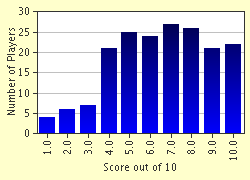Quiz Answer Key and Fun Facts
1. Miss Marple, the keen-witted spinster sleuth whose hobbies include gardening and observing "human nature", was introduced in the 1935 mystery "Murder at the Vicarage". In this novel, the murderer is caught out when he makes the mistake of presenting Miss Marple with a rock for one of her oriental gardens. What telling detail did Miss Marple notice about the rock that aroused her suspicion?
2. Miss Marple's close friend Dolly Bantry shares her passion for gardening, a fact which enables them both to solve one of the mysteries that comprise the short story collection "The Thirteen Problems" (a.k.a. "The Tuesday Club Murders"). They notice that certain key words in a letter connected with the case are identical with the names of several cultivars of dahlia. In which story does this occur?
3. Miss Marple greatly enjoys gardening, and is extremely upset when (in "The Mirror Crack'd") she is compelled by doctor's orders to give up her pastime and hire a gardener. For Hercule Poirot, however, gardening proved far less congenial. In "The Murder of Roger Ackroyd", Poirot has taken up gardening as a hobby to pass the time after his retirement, but is only too glad to abandon this pastime to solve a murder. What was it that Poirot had devoted himself to cultivating (not with much success)?
4. In the short story "How Does Your Garden Grow?", a jarring detail in an otherwise beautiful garden provides Poirot with the clue he needs to solve the poisoning of an elderly woman. What was the detail?
5. In one Christie novel, a series of murders are committed in order to obtain enough money to create a garden paradise on a Greek Island. In which of these later Christie novels (which features Hercule Poirot as the detective, "assisted" by Ariadne Oliver) does this occur?
6. In "Murder in Retrospect" (a.k.a. "The Five Little Pigs"), Poirot is called upon to investigate a murder that had occurred sixteen years earlier. The celebrated artist Amyas Crale had been poisoned with coniine, a crime for which his wife Caroline had been convicted. One of the key witnesses is Meredith Blake, a friend of the Crales, whose hobby is distilling potions from herbs and other plants (the poison had actually been taken from his laboratory). At one point, Poirot uses the scent of a particular flower to trigger Blake's memory about the day before the murder, yielding an important clue. What flower was it?
7. "The Herb of Death" is one of the stories which comprise the short story collection "The Thirteen Problems" (a.k.a. "The Tuesday Club Murders"). In this story, several people become ill- and a young woman dies- when the leaves of a certain plant are gathered along with sage leaves and served in the food. What type of plant is it?
8. In the Poirot mystery "Sad Cypress", the murderer is caught out when Poirot notices an unusual detail of a certain rosebush which was growing outside the cottage where the murder was commited. What notable feature did the rosebush lack which enabled Poirot to solve the case?
9. "Nemesis" features Miss Marple, who is called upon posthumously by the late Jason Rafiel to solve a murder, about which she has been provided with no information. She is sent upon an all-expenses paid garden tour, during which she gathers clues about the murder she must solve. The plant that catches her attention the most is not one of the many plants she sees on the tour, but a flowering vine called Polygonum Baldschaunicum, which covers the ruins of a greenhouse on the property of a home where she is staying as a guest. What are the chief characteristics of Polygonum Baldschaunicum, as described in the novel?
10. A dilapidated greenhouse plays a major role in "Postern of Fate", which features Tommy snd Tuppence Beresford. In this mystery, the aging Beresfords move into a new home and discover clues to a murder that had taken place years earlier, at the outbreak of the second World War. A young woman named Mary Jordan had died, apparently from an accidental poisoning, but a boy named Alexander Parkinson left clues in an old book that she had been murdered by "one of us". A major clue to the mystery is found in an abandoned nursery toy, which has been stored in an old greenhouse on the grounds. What toy holds the clue to the mystery?
Source: Author
jouen58
This quiz was reviewed by FunTrivia editor
agony before going online.
Any errors found in FunTrivia content are routinely corrected through our feedback system.

